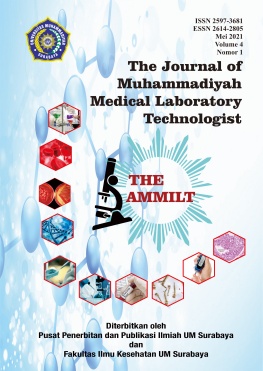Isi Artikel Utama
Abstrak
Rincian Artikel
Referensi
- Arneth, B. M. and Menschikowki, M. (2015) ‘Technology and New Fluorescence Flow Cytometry Parameters in Hematological Analyzers’, Journal of Clinical Laboratory Analysis. John Wiley and Sons Inc., 29(3), pp. 175–183. doi: 10.1002/jcla.21747.
- Daves, M. et al. (2015) ‘Sample stability for complete blood cell count using the Sysmex XN haematological analyser’, Blood Transfusion. SIMTI Servizi Sri, 13(4), pp. 576–582. doi: 10.2450/2015.0007-15.
- Jain, A. et al. (2018) ‘Storage stability of commonly used haematological parameters at 33 °c’, Biochemia Medica. Biochemia Medica, Editorial Office, 28(2 Special Issue). doi: 10.11613/BM.2018.020901.
- Kemenkes (2010) Peraturan Menteri Kesehatan Republik Indonesia Nomor 411 Tahun 2010 Tentang Laboratorium Klinik. Jakarta. Available at: http://dinkes.babelprov.go.id/sites/default/files/dokumen/produk_hukum/PMK No. 411 ttg Laboratorium Klinik.pdf.
- Keohane, E. M., Smith, L. J. and Walenga, J. M. (2016) Rodaks’s Hematology: Clinical Principles and Application. 5th edn. Missouri: Elsevier.
- Nah, E. H. et al. (2018) ‘Complete blood count reference intervals and patterns of changes across pediatric, adult, and geriatric ages in Korea’, Annals of Laboratory Medicine. Seoul National University, Institute for Cognitive Science, 38(6), pp. 503–511. doi: 10.3343/alm.2018.38.6.503.
- Plebani, M. (2012) ‘Quality indicators to detect pre-analytical errors in laboratory testing.’, The Clinical biochemist. Reviews. The Australian Association of Clinical Biochemists, 33(3), pp. 85–8. Available at: http://www.ncbi.nlm.nih.gov/pubmed/22930602 (Accessed: 3 December 2020).
- Tang, O. et al. (2019) ‘Short-Term Stability of Hematologic Parameters in Frozen Whole Blood’, The journal of applied laboratory medicine. NLM (Medline), 4(3), pp. 410–414. doi: 10.1373/jalm.2018.028357.
- Wu, X. et al. (2015) ‘Complete Blood Count Reference Intervals for Healthy Han Chinese Adults’, PLOS ONE. Public Library of Science (PLoS), 10(3), p. e0119669. doi: 10.1371/journal.pone.0119669.
- Zini, G. (2014) ‘Stability of complete blood count parameters with storage: Toward defined specifications for different diagnostic applications’, International Journal of Laboratory Hematology. Blackwell Publishing Ltd, pp. 111–113. doi: 10.1111/ijlh.12181.
Referensi
Arneth, B. M. and Menschikowki, M. (2015) ‘Technology and New Fluorescence Flow Cytometry Parameters in Hematological Analyzers’, Journal of Clinical Laboratory Analysis. John Wiley and Sons Inc., 29(3), pp. 175–183. doi: 10.1002/jcla.21747.
Daves, M. et al. (2015) ‘Sample stability for complete blood cell count using the Sysmex XN haematological analyser’, Blood Transfusion. SIMTI Servizi Sri, 13(4), pp. 576–582. doi: 10.2450/2015.0007-15.
Jain, A. et al. (2018) ‘Storage stability of commonly used haematological parameters at 33 °c’, Biochemia Medica. Biochemia Medica, Editorial Office, 28(2 Special Issue). doi: 10.11613/BM.2018.020901.
Kemenkes (2010) Peraturan Menteri Kesehatan Republik Indonesia Nomor 411 Tahun 2010 Tentang Laboratorium Klinik. Jakarta. Available at: http://dinkes.babelprov.go.id/sites/default/files/dokumen/produk_hukum/PMK No. 411 ttg Laboratorium Klinik.pdf.
Keohane, E. M., Smith, L. J. and Walenga, J. M. (2016) Rodaks’s Hematology: Clinical Principles and Application. 5th edn. Missouri: Elsevier.
Nah, E. H. et al. (2018) ‘Complete blood count reference intervals and patterns of changes across pediatric, adult, and geriatric ages in Korea’, Annals of Laboratory Medicine. Seoul National University, Institute for Cognitive Science, 38(6), pp. 503–511. doi: 10.3343/alm.2018.38.6.503.
Plebani, M. (2012) ‘Quality indicators to detect pre-analytical errors in laboratory testing.’, The Clinical biochemist. Reviews. The Australian Association of Clinical Biochemists, 33(3), pp. 85–8. Available at: http://www.ncbi.nlm.nih.gov/pubmed/22930602 (Accessed: 3 December 2020).
Tang, O. et al. (2019) ‘Short-Term Stability of Hematologic Parameters in Frozen Whole Blood’, The journal of applied laboratory medicine. NLM (Medline), 4(3), pp. 410–414. doi: 10.1373/jalm.2018.028357.
Wu, X. et al. (2015) ‘Complete Blood Count Reference Intervals for Healthy Han Chinese Adults’, PLOS ONE. Public Library of Science (PLoS), 10(3), p. e0119669. doi: 10.1371/journal.pone.0119669.
Zini, G. (2014) ‘Stability of complete blood count parameters with storage: Toward defined specifications for different diagnostic applications’, International Journal of Laboratory Hematology. Blackwell Publishing Ltd, pp. 111–113. doi: 10.1111/ijlh.12181.

